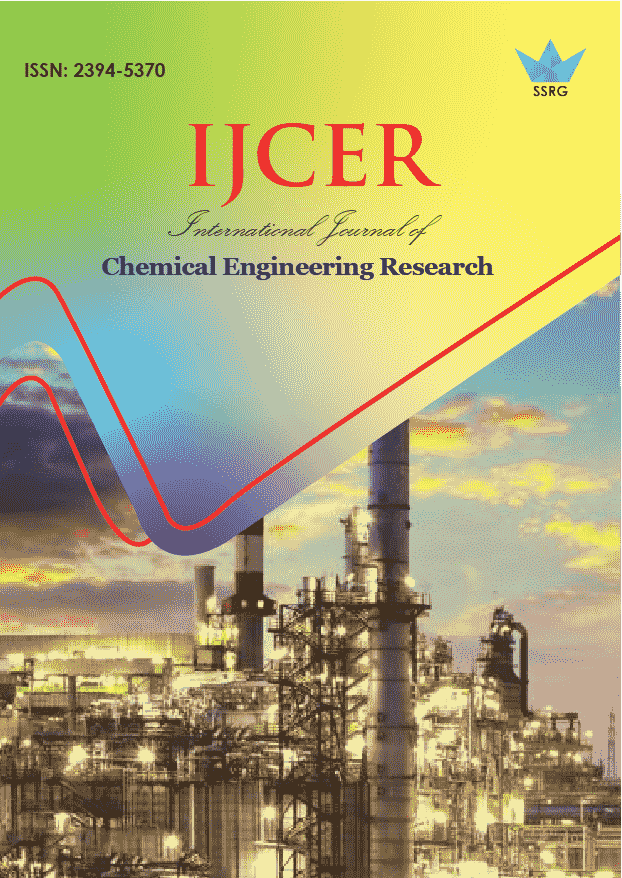Green Synthesis of Zinc-Oxide and Titanium Dioxide Nanoparticles

| International Journal of Chemical Engineering Research |
| © 2019 by SSRG - IJCER Journal |
| Volume 6 Issue 1 |
| Year of Publication : 2019 |
| Authors : Vijitha G, Vaigainithiya M, Bhuvaneswari R |
How to Cite?
Vijitha G, Vaigainithiya M, Bhuvaneswari R, "Green Synthesis of Zinc-Oxide and Titanium Dioxide Nanoparticles," SSRG International Journal of Chemical Engineering Research, vol. 6, no. 1, pp. 1-3, 2019. Crossref, https://doi.org/10.14445/23945370/IJCER-V6I1P101
Abstract:
Nanotechnology is one of the latest and fastest spreading research in all walks of life. The present work describes synthesis of a Zinc oxide and Titanium dioxide nanoparticles by biological (green) method. Of all the other methods, biological (green) methods are the most preferred and the easiest method. This is because of their non toxic, cost effective, easily and abundantly available feature. Titanium dioxide (TiO2) and Zinc-oxide (ZnO) nanoparticles are synthesized from the leaf extracts of Nerium Oleander (Oleander) and Azadirachta indica (Neem) by the methods of co-precipitation. Plant extracts may act both as stabilizing agents, capping agents and as reducing agents in the synthesis of nanoparticles. The synthesized TiO2 and ZnO particles were analyzed by Fourier transform infra red spectroscopy to find the characteristic molecular groups and Particle size Analyzer was used for detecting the size of the nano-catalytic particles to confirm in the Nano-range.
Keywords:
Biological (green) synthesis; Fourier transform infra red spectroscopy (FTIR);
References:
[1] Dr. Keshav K. Deshmukh1, Goraksh J. Hase, 2018. “Titanium Oxide Nanoparticles and Degradation of Dye by Nanoparticles”, International Journal of Materials Science volume 13, number 1 (2018), pp.23-30.
[2] K. Ganapathi Rao, CH. Ashok, K. Venkateswara Rao*, CH. Shilpa Chakra, Pavani Tambur, 2015. “ Green Synthesis of TiO2 Nanoparticlea Using Aloa Vera Extract”, International Journal of Advanced Research in Physical Science (IJARPS), Volume 2, Issue 1A, PP 28-34.
[3] Thirunavukkarasu Santhoshkumar, Abdul Rahuman, 2014. “ Green Synthesis of Titanium dioxide nanoparticles using Psidium guajava exract and its antibacterial and antioxidant properties”, Asian Pacific Journal Of Tropical Medicine.
[4] Vivek Patidar1, Preeti Jain 2, 2017. “ Green Synthesis of TiO2 Nanoparticle Using Moringa Oleifera Leaf Extract”, International Research Journal of Enginerring and Technology (IRJET), volume:04, P- ISSN: 2395-0072.
[5] Subhapriya S., Gomathipriya P, 2018. “ Green synthesis of Titanium Dioxide (TiO2) nanoparticles by Trigonella foenum-gracum extract and its antimicrobial properties”, Microbial Pathogenesis.
[6] Irene Georgaki, Eva vasilaki, Nikos Katsarakis, 2014. “ A Study on the Degradation of Carbamazepine and Ibuprofen by TiO2 and ZnO photocatalysis upon UV/ Visible- LightIrradiation”, American Journal of Analytical Chemistry, 5, 518-534.
[7] Manoj A. Lazar, Shaji Varghese and Santhosh S. Nair, 2012, “Photocatalytic Degradation of Pharmaceutical Waste by Titanium Dioxide: Recent Updates”, catalysts 2012, ISSN 2073-4344, volume 2, PP.572.601.
[8] M.R. Hoffmann, S. T. Martin, W. Choi and D.W. Bahnemann, 1995, “Environmental Applications of Semiconductor Photocatalysis”, Chem. Rev., Vol. 95, NO.1, pp. 69-96.
[9] Jose Rivera-Utrilla, Manuel Sanchez-Polo, Maria Angeles Ferro-Garcia, Gonzalo Prados-Joya, Raul Ocampo-Perez, 2013. “Pharmaceuticals as Emerging Contaminants and theirRemoval from Water, A Review”, chemosphere, 1268-1287.
[10] Farley S. Braz, Milady R. A. Silva, Flávio S. Silva, Sandro J. Andrade1, Ana L, Fonseca, Márcia M. Kondo, 2014, “Photocatalytic Degradation of Ibuprofen Using TiO2 and Ecotoxicological Assessment of Degradation Intermediates against Daphnia similis”, Journal of Environmental Protection, 5, 620-626.
[11] Sharmila Devi R., Venckatesh R., RajeshwariSivaraj, 2014, “Synthesis of Titanium Dioxide Nanoparticles by Sol-Gel Technique”, International Journal of Innovative Research in Science, Engineering and Technology, Vol. 3, ISSN 2319 - 8753, Issue 8.
[12] Rajesh Nithyanandam and Raman Saravanane., 2013, “Treatment of Pharmaceutical Sludge by Fenton Oxidation Process”, International Journal of Chemical Engineering and Applications, Vol. 4, No.6.
[13] M. R. Hoffmann, S. T. Martin, W. Choi and D.W. Bahnemann,1995, “Environmental Applications of Semiconductor Photocatalysis”, Chem. Rev., Vol. 95, No.1, pp. 69-96.

 10.14445/23945370/IJCER-V6I1P101
10.14445/23945370/IJCER-V6I1P101